Arts Miami
Tony Japour Explores the Work of Susan Rothenberg
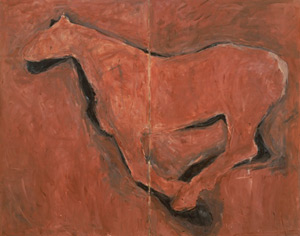

Anthony Japour (AJ) is an independent curator, private art dealer and owner of AJ Japour Gallery. The gallery deals in contemporary art with a focus on the Chinese Contemporary Art Movement and its relationship to the pillars of Western Contemporary Art. Since 2003, AJ has produced numerous art exhibitions and installations in Miami and South Florida. In addition, the Gallery’s secondary mission is to support organizations dedicated to the health, education, and welfare of children. AJ has served on the Fine Arts Board and the Cultural Arts Council of the City of Miami Beach.

What I find so engaging about the art world is the opportunity for life-long learning and discovery. Like that of painter Susan Rothenberg, widely known within the American contemporary art circles as the artist’s artist, but not as well known by the general public or the international art community. In that regard, Miami Art Museum has endowed a great civic gift to the history of art in America by exhibiting Susan Rothenberg during the time of the year when everyone is talking about art in Miami; namely, Art Basel-Miami Beach.
When confronted with the term “artist’s artist”, which is an awfully important title, I had to ask why? It implies “leading the way” for other artists and after touring the exhibit under the expert guidance of MAM’s Senior Curator, Peter Boswell, I came away with the idea that Susan Rothenberg, born in Buffalo, New York and educated at Cornell University, led American painters back from abstraction and minimalism to figuration in the last third of the 20th Century’s art production.

To put Rothenberg into the appropriate art historical context, it is important to know that midcentury American abstract expressionism from the 1940’s through the Cold War years of 1950’s is considered to be the first innovation America brought to the western art world. As a reaction to and a natural development thereof, pop art and minimalism emerged in the 1960’s. Rothenberg came to age during the height of minimalism with no subject matter at all rendered as monochromatic canvasses typified by Robert Ryman and iterative sculptural geometric elements by Donald Judd. In an art conversation with Peter Boswell and Michael Auping, chief curator at the Modern Art Museum of Fort Worth and curator of the exhibition, Rothenberg admitted her trepidation in approaching painting against the backdrop of minimalism and sculptors like Richard Serra heaving molten steel against a wall.
Nevertheless, Rothenberg forged ahead with her painting career with the figure of a horse. And, over the decades she has become viewed as one of the most important American painters, a painter’s painter, of our time. Described as having “burst” on the scene in the 1970’s and often being the only woman in New York City’s male-dominated contemporary art scene, Rothenberg is best known for her horse paintings. Initially, inspired by the line created by a seam stitching two canvases together in one of her early works, Rothenberg began her intimate relationship with the line in her horse paintings.
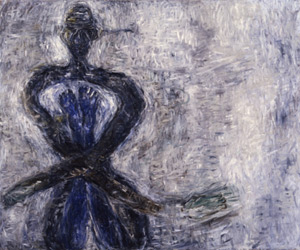
The MAM exhibition begins with an important early work of acrylic and tempera on canvas, Cabin Fever, 1976. One sees the silhouette and shadow of a horse mid-gallop; but immediately the eye is drawn to the line that bisects the canvas. From here, Rothenberg’s paintings begin to breakdown the anatomy of the horse into its component parts using the line as a reference point to create at once the elements of abstraction, minimalism, and figuration within a single work of art. Robert Storr, critic, curator and dean of the Yale School of Art has described Rothberg’s work as “an organic product of her method . . . the image being the final stage of an incremental process of statement, revision, cancellation, and restatement.”
In Blue Frontal, 1978 what would initially look like an abstract painting to the casual observer is immediately recognized as a horseshoe shaped coming together of two horse legs. Here she references her earlier horse figures but she begins to breakdown the anatomy to its component parts. To her, it looked “almost human” and was closely followed by Hands and Shadows, 1978-79 which nearly replicates Blue Frontal, 1978 but now one sees the human figure as a pair of human arms in a first position ballet configuration if looking from above and simultaneously fifth position with the arms crowing the head. In this work one begins to see the movement and torque that has been described in Rothenberg’s later works.
While the line begins to disappear from her later works, perhaps as the artist gained more confidence, it remerges in an important work, Folded Buddah, 1987-88 gifted to the Miami Art Museum by Mimi and Bud Floback. Folded Buddah, I learned during Rothenberg’s talk, is a highly emotional piece for her because it focuses on the “empty middle” suggesting the ability of letting air flow through the body as in the act of inspiration and expiration as well as a kind of emptiness we feel at different times in our lives.
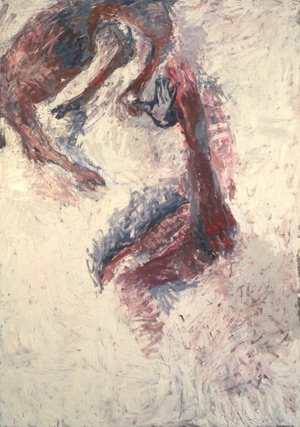
In 1990, Rothenberg moved from New York to New Mexico with her husband, artist Bruce Nauman where, as Boswell observed and Rothenberg’s concurred, her paintings take on a narrative quality previously absent. In Chinese Goat, 1991-92, the animals become more animated and in successive works the horse figure remains prominent but a menagerie of animals – dogs, rabbits, goats and deer appear in excited interactions.
In the late 1990’s- early 2000’s, the artist moved indoors with a series of quietly contemplative but intricate and complex domestic settings featuring vibrant primary colors of blue, yellow and red. Critics have compared these works to Henri Matisse’s famous red interiors. One can’t help but speculate about the complexity of Rothenberg’s paintings circa 1990-2000’s and its connection to her giving up her life in New York to move to a distant place in domesticity alternating between excited states and quiet bliss with her husband, Bruce Nauman, something of a rock star in the contemporary art world.
Toward the end of her conversation with Auping and Boswell, Rothenberg, who couldn’t have been more gracious and self-revelatory, gave a sneak preview of her current work, which is a return to the figure, now in the form of a black raven.
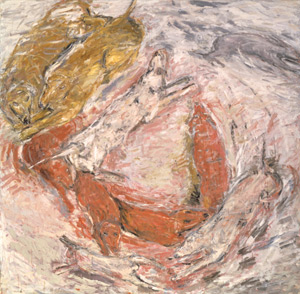
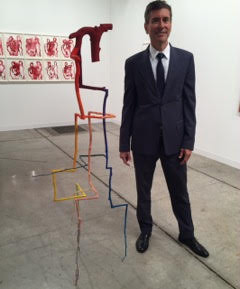
Anthony Japour is an art collector and art advisor. Japour lectures on the Chinese Contemporary Art Movement and its relationship to the pillars of Western Contemporary Art. For over a decade [2002-2012], Japour mounted numerous art exhibitions and installations in Miami Beach and South Florida through AJ Japour Gallery and linked these exhibitions to charity events at his home in South Beach devoted to the health, education and welfare of children. Japour has served on the Fine Arts Board and the Cultural Arts Council of the City of Miami Beach. Japour has been a contributor writing on contemporary art for SocialMiami.com since 2010.


